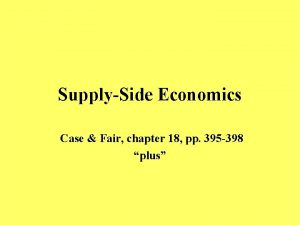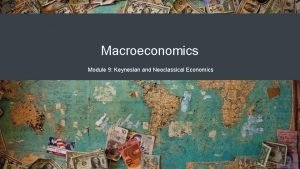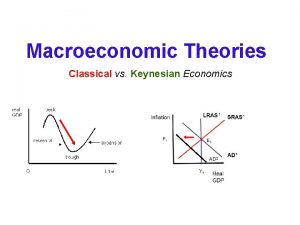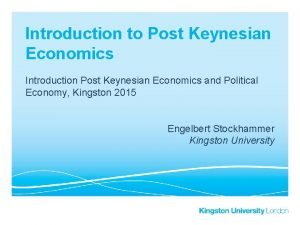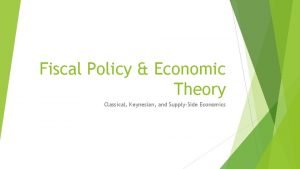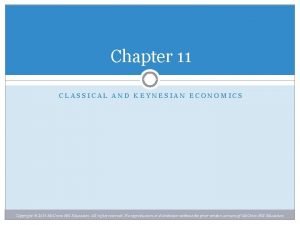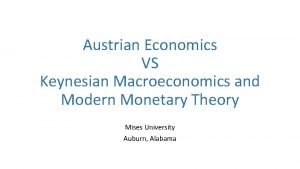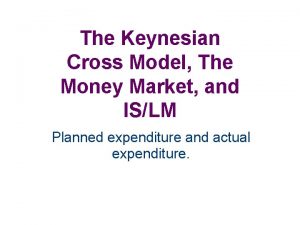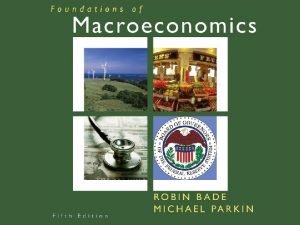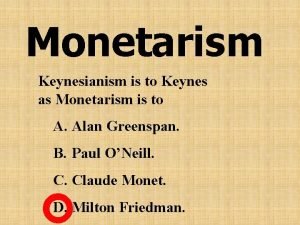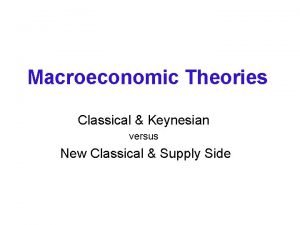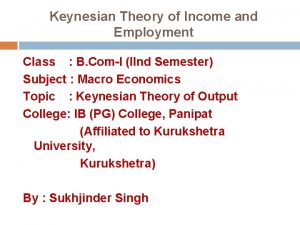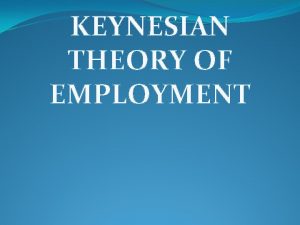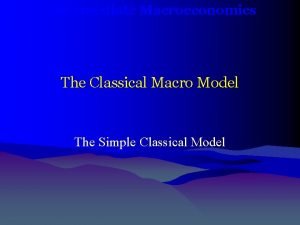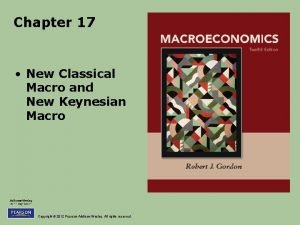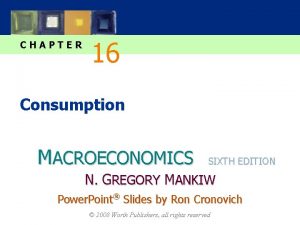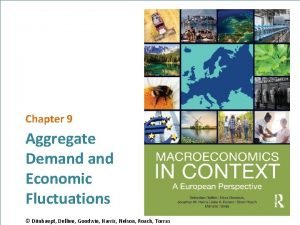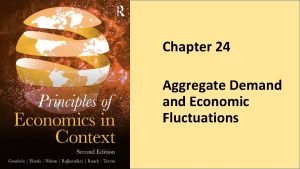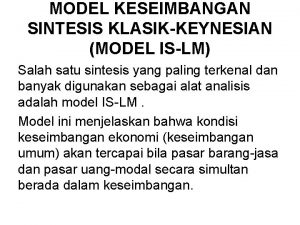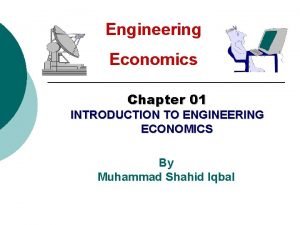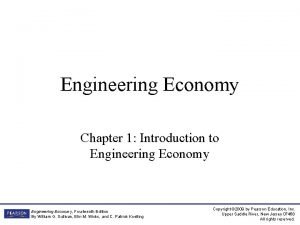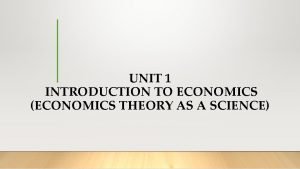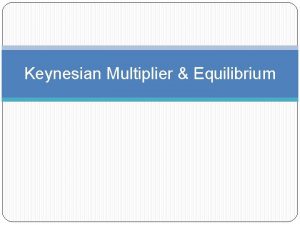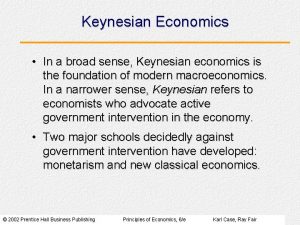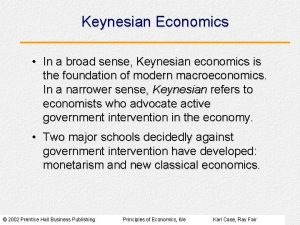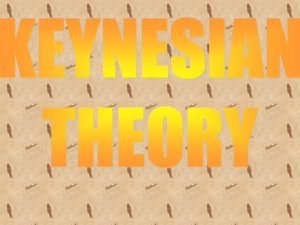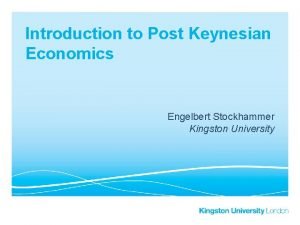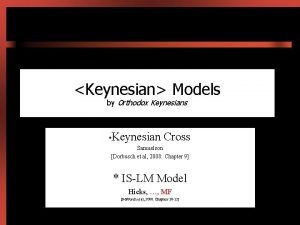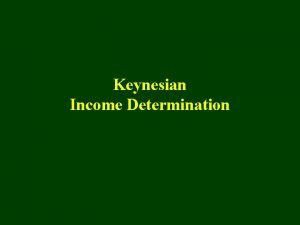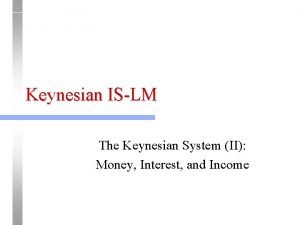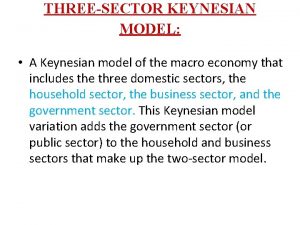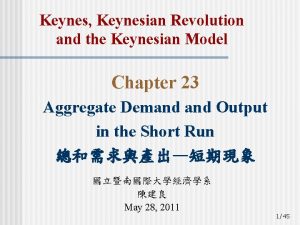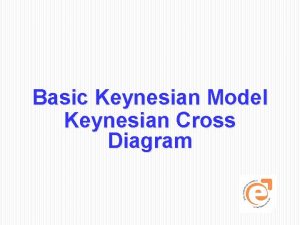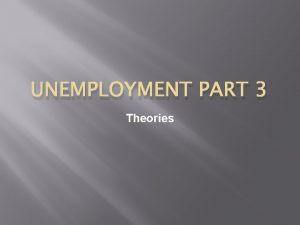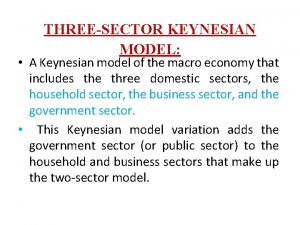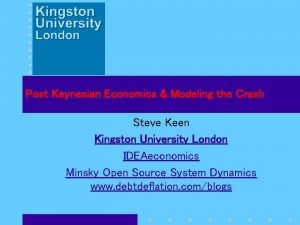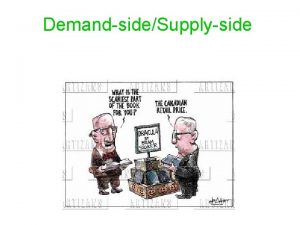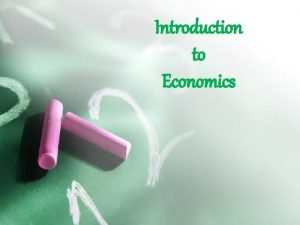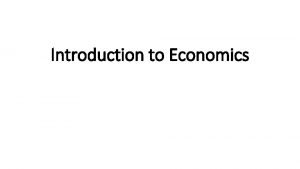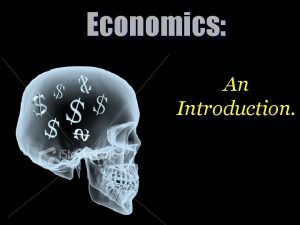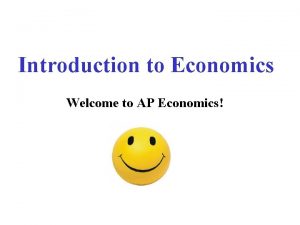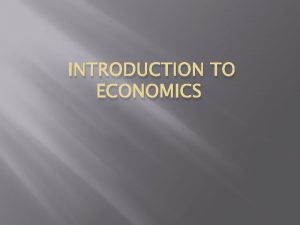Introduction to Post Keynesian Economics Introduction Post Keynesian




























- Slides: 28

Introduction to Post Keynesian Economics Introduction Post Keynesian Economics and Political Economy, Kingston 2015 Engelbert Stockhammer Kingston University

Outline • Foundations • Fundamental uncertainty • Social conflict • Effective demand • Macroeconomics • Investment → savings • Involuntary unemployment • Credit → money • Financial instability • Context: • History of PKE; • Synthesis and New Keynesians • PKE and Marxian PE • Economic Policy

Post Keynesian Economics Effective demand Fundamental uncertainty Social conflict

Fundamental uncertainty • ‘we simply don’t know’ • That’s a statement about the world, not about human cognitive abilities • People can’t be ‘rational’, instead • They rely on conventions = look what other people are doing (social norms, anchoring, institutions) • Assume that the future is similar to the past (adaptive expectations) • Conventions can change rapidly (herd behaviour) • Money as a means to deal with uncertainty → liquidity preference • Possibility of liquidity crises and panic • Investment demand driven by animal spirits • Can’t make a ‘rational’ decision about long time horizon

Social conflict • Distributional conflict • PK models: often 3 classes: workers, capital, rentiers/financial capital • Capital hires labour; firing threat as disciplinary advise • Capitalists make investment decisions • Rentiers advance capital and receive interest + dividend payments • Have different consumption propensities • Institutions regulate and mediate conflicts • Inflation as the outcome of unresolved distributional conflicts • Note: workers and uncertainty? job insecurity

Effective demand • I(Y) = S(Y) • Investment → savings via multiplier process • Investment not constrained by saving, but possibly by the availability of finance • Investment expenditures are the single most important determinant of fluctuations in GDP • Have strong non-rational component • Private goods market equilibrium will in general not be at full employment equilibrium

UK: investment, consumption, GDP 10. 0% 5. 0% 0. 0% -5. 0% -10. 0% -15. 0% 13 20 12 20 11 20 10 20 09 20 08 20 07 20 06 20 05 20 04 20 03 20 02 20 20 01 GDP growth inv growth cons growth

Involuntary unemployment • Labour market is not self-adjusting; cannot serve as the anchor of the economy • Wage contract are nominal contracts • Wage cuts → reduction in consumption demand • → downward pressure on prices • → possibility of debt-deflation spiral • Real wage cut: workers have higher MPC than capitalists • → real wage cut will be contractionary unless investment is very sensitive to profit margins • ∑ No self adjustment towards full employment • Labour market dragged along with goods market; strong hysteresis

Money & finance • Endogenous money: credit → money • CB sets the interest (base) rate • Private financial institution mark up according to their liquidity preference (risk premium) • Financial markets prone to instability b/e forward looking (fundamental uncertainty) • Debt cycles a la Minsky: during boom investors become willing to take more risk = higher leverage = system become more fragile → endogenous cycles • Inflation as the outcome of unresolved distributional conflictions: if capital, labour and finance can’t agree on their income shares

UK: cycles in r. Loans and r. GDP Source: Haldane (2012 BIS WP)

PK: development and streams • 1950 s + 60 s: Keynes in the long run – distribution and growth; • Capital Controversies; • critique of neoclassical-Keynesian Synthesis (ISLM etc) • Where? Cambridge • 70 s + after: formation of PK school (journals); spreading out • Conflict inflation; endogenous money • Shift towards short/medium run analysis (Kaleckian models): distribution and demand, wage-led growth • Financial instability (Minsky) • More on economic policy, more empirical • Where? Lost Cambridge -> spreading out (USA, continental Eu. . ) • Streams • • Sraffians: long run, distribution, technology and prices Monetary Keynesians (incl. Minsky): uncertainty, money, short term Kaleckians: social conflict, distribution, demand; short/medium term Various other (often narrower streams): Bo. PC growth, SFC, MMT. . .

Neoclassical vs Keynesian theory Neoclassical theory Keynesian theory Key concepts Rational behaviour, equilibrium Effective demand, ‘animal spirits’ Behaviour Rational behaviour by selfish individuals ‘animal spirits’ (non-rational behaviour) and conventional Markets Market clearing ← prices adjustment Some markets don’t clear Money Classical dichotomy (money is neutral) ‘money matters’ (has real effects) unemployment Voluntary or due to rigidities Involuntary, due to lack of demand on goods markets policy Laissez faire: markets are selfregulating and gov’t should not intervene market economies are unstable and result in unemployment → gov’t should intervene

Schools of thought in macroeconomics Marx Keynes neoclassical Synthesis Keynesians Postkeynesians New Keynesians New Classcial Econ Monetarism Rational Expectations RBC

New Keynesians • in 1980 s (Mankiw, Blanchard, Stiglitz, Fisher) • reaction to New Classicals - accept microfoundations and often rational expectations • but assumes (or derives) imperfect markets – • menu costs, • NAIRU, insider outsider models • credit rationing / asymmetric information • 1990 s: “New Consensus Model” (New Keynesian-Neoclassical Synthesis): • again short run/long run dichotomy, but with strict microfoundations • Pseudo IS curve: downwards sloping because of intertertemporal consumption

PKE Marxian econ scope Economic theory Part of richer, interdisciplinary project (Historical Materialism) Demand Effective demand Often assumes Say’s law; demand (‘realisation crisis’) only in short run Production Little to say to production Production as labour process Class analysis classes have different consumption propensities; only capitalists make investment decisions Class struggle at site of production Class struggle -> theory of state Money & finance Money is created by banks as side effect of lending Money to deal with uncertainty Commodity theory of money: money is produced commodity unemploy ment Lack of effective demand; no tendency to full employment Industrial reserve army necessary to discipline workers policy Normative: full employment policy; can also benefit capital Reform futile within the capitalist system

PK and mainstream economic policy Mainstream Policy Mix Post Keynesian Policy Mix Overall aim Efficiency (minimal interference in markets) Full employment fiscal policy Balanced budgets (‘sound fiscal policy’) Countercyclical fiscal policy to ensure full employment Monetary policy Inflation targeting Has to support growth; In recession with debt hangover: higher inflation allows rebalancing Labour market Encourage ‘labour market flexibility’ Wage as a cost factor Institution building Financial market Wages as source of demand financial liberalisation, Regulate finance trusts efficiency of financial markets

Reading suggestions classics • Keynes: General Theory of Employment, Interest and Money • Kalecki: Theory of Economic Dynamics • Robinson: Accumulation of Capital • Minsky: Stabilizing an Unstable Economy Introductions, surveys, history • Lavoie: Introduction to Post Keynesian Economics • Hein & Stockhammer: A New Guide to Keynesian Macroeconomics and Economic Policies • King: History of Post Keynesian Economics

Conclusion: PKE • foundations • Fundamental uncertainty • Social conflict • Effective demand • Macroeconomics • Investment → savings • Involuntary unemployment • Credit → money • Financial instability

Appendix

PKSG & PERG An Introduction to Post Keynesian Economics and Political Economy 10 -12 July 2014, Kingston University E Stockhammer, M Sawyer, V Chick, S Mohun, J Wells, A Higginbottom, G Dymski http: //fass. kingston. ac. uk/research/perg/ events/ • PKSG Annual Workshop, June • FMM conference, Oct • FMM summer school, Aug, every other year • PKSG email list http: //www. postkeynesian. net/


PK goods market: basic multipliers • • • Standard Keynesian multiplier C = c 1. Y +c 0 I = I 0 In equilibirum Y = C + I 0 Y* = 1/(1 -c 1). (C 0+I 0)

Different consumption propensities for profit income and wage income • • C = c. W. W + CR. R π=R/Y (profit share) C = c. W. (1 -π). Y + c. R. π. Y Y = c. W. (1 -π). Y + c. R. π. Y + c 0 + I 0 Y* = 1/(1 - c. W +π[c. W - c. R]). (c 0 + I 0) • • If workers don‘t save: c. W = 0 Y* = 1/π(1 -c. R). (c 0 + I 0) d. Y*/d I 0 = 1/π(1 -c. R) d. Y*/dπ = -1/π2(1 -c. R) < 0

Wage-led versus profit-led demand • Y = C + I + NX • Increase in profit share • Negative effect on consumption • Positive effect on investment • Positive effect on net export (for an individual country) • Y = C(Y, π) + I(Y, i, π) + NX(Y, π; YW, ex) • • • Y income, i. . Interest rate, π. . profit share, D. . debt, YW. . world GDP, ex. . exchange rate, P. . price level, p. . inflation d. Y*/dπ = h 1/(1 -h 2) h 2 = d. C/d. Y + d. I/d. Y + d. NX/d. Y h 1 = d. C/dπ + d. I/dπ + d. NX/dπ neg + pos = ? ? • • If h 1 > 0 profit-led demand If h 1 < 0 wage-led demand

Net Effects: ∆Y/∆WS Effects on private excess demand EU 12 (openness 15%) Austria (openn. 50%) Consumption 0. 37 0. 36 Investment -0. 07 -0. 15 Domestic sector 0. 30 0. 21 Net exports -0. 09 -0. 39 Total effect 0. 21 -0. 18 25

Comments about the state of ‘Economics’ • Theoretical and methodological monoculture (‘neoclassical economics’) • Microfoundations (rational behaviour) • a scholastic science: self-referential • Journal ratings • RAE/REF • Has proven utterly dysfunctional as regards the crisis • CB models don’t have a role for the financial sector or bankruptcies • DSGE models regard the crisis as a ‘random shock’ • EMH has encouraged financial deregulation

Teaching Economics: pluralism! • Different theories: neoclassical, New Keynesian, neo-Austrian, Post Keynesian, Marxist, Behavioural Econ • Problem-oriented (as opposed to theory guided): • Topics like unemployment, financial crises … • Economic history! • Should encourage methodological pluralism: quantitative as well as qualitative methods

Illustrating different paradigms Austrians Mainstream PK Marxist ‘too low interest rates’ Random shock; Wrong incentives to bank mangers → excessive risk taking Unregulated financial (animal spirits + endogenous credit) → boom-bust cycles Reflects more fundamental contradictions of capitalism (exploitation) Recession / Economic crisis unemployment as cleansing process Swift return to equilibrium No built-in mechanism to return to full employment Unemployment a normal feature; necessary to maintain discipline Government interventions May be useful in short run Necessary for socially desirable outcomes Futile in capitalism Financial crisis avoid
 Supply vs demand side economics
Supply vs demand side economics Classical versus keynesian economics
Classical versus keynesian economics Classical economics vs keynesian
Classical economics vs keynesian Keynesian policy
Keynesian policy Keynesian economics policy
Keynesian economics policy Keynes law
Keynes law Austrian economics vs keynesian
Austrian economics vs keynesian School of business and economics maastricht
School of business and economics maastricht What is mathematical economics
What is mathematical economics Keynesian cross
Keynesian cross Keynesian cross
Keynesian cross Monetarist vs keynesian vs classical
Monetarist vs keynesian vs classical Keynesianism
Keynesianism Monetarist vs classical economics
Monetarist vs classical economics Explain the keynesian theory of employment
Explain the keynesian theory of employment Keynesian and classical theory
Keynesian and classical theory Keynesian consumption function
Keynesian consumption function Keynesian vs classical vs monetarist
Keynesian vs classical vs monetarist Keynesian consumption function
Keynesian consumption function New classical and new keynesian macroeconomics
New classical and new keynesian macroeconomics Keynesian model
Keynesian model Keynesian model
Keynesian model Model islm
Model islm New classical and new keynesian macroeconomics
New classical and new keynesian macroeconomics Branches of economics
Branches of economics Introduction to engineering economics
Introduction to engineering economics Unit 1 economics
Unit 1 economics Engineering economy problems
Engineering economy problems Unit 1 introduction to economics
Unit 1 introduction to economics
